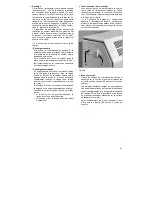
26
•
Operation
The heater operation is silent. The only mechani-
cally moving part is the air mixing plate (d, fig. 28).
The thermal expansion of the core is absorbed by
the insulation.
The heat dissipation into the room is 80% via natu-
ral convection, and 20% is radiated into the room
from the heater surfaces.
The convection processes cause an air-stream
from the surfaces of the heater into the upper lay-
ers of the room. Colder air masses are displaced,
causing a hardly noticeable air circulation which al-
lows for a gradual and even heating of the room.
fig.28
•
Charging
The adjustment of the charge takes place using the
operating knobs on the top right of the heater (e,
fig.29a).
The appliances are fitted with a thermo-mechanical
regulator, which monitors the heater charge ac-
cording to the core temperature. The residual heat
left in the core from the previous day is continu-
ously taken into account. An additional tempera-
ture safety control is fitted as a separate safety
element.
The charge can be adjusted continuously from
zero (control knob fully anticlockwise) to full charge
(control knob fully clockwise “max.“). The charge
control switches off the elements automatically on
reaching the set charge.
The “max.“ adjustment should only be used on the
coldest days. The setting best suited to the ambi-
ent conditions is ideally found by trial and error.
fig.29a
•
Manual reset cut-out
All storage heaters are fitted with a manual reset
cut-out, which will isolate the appliance in the event
of a fault occurring causing the heater to overheat.
This device must be reset by a competent electri-
cian, and the appliance inspected to determine the
reason for operation of the control.
Possible faults:
- Defective charge control regulator B1.
- Appliance has been draped/covered causing heat
stagnation.
Konvektion
convection 80%
Strahlung
radiation 80%
















































